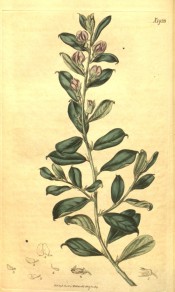Podalyria sericea R.Br.
Frost-tender spreading shrub with obovate leaves, to 2cm long, covered with silvery hairs ageing to gold, and solitary, fragrant, pea-like lavender–blue to lavender-pink flowers, to 1cm across, from autumn to spring. To 90cm. [RHSE, Hortus].
Horticultural & Botanical History
‘The Podalyria sericea is not an uncommon shrub in our greenhouses, and recommends itself by its fine silky foliage; but does not very often blossom: when it does so, it is always, as far as we have seen, in the winter months, from November to February. Native of the Cape of Good-Hope. Propagated by cuttings. Communicated by our friends Messrs. Loddiges and Sons.’ [BM t.1923/1817].
Introduced to Britain in 1778. [JD]. LBC no.1442/1830.
History at Camden Park
Listed in all published catalogues [T.768/1843]. Loddiges’ nursery is the likely source.
Notes
Published Dec 24, 2009 - 02:36 PM | Last updated Jul 21, 2010 - 12:39 PM
| Family | Fabaceae |
|---|---|
| Category | |
| Region of origin | South Africa |
| Synonyms | |
| Common Name | |
| Name in the Camden Park Record |
Podalyria sericea |
| Confidence level | high |
